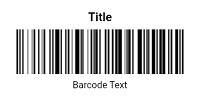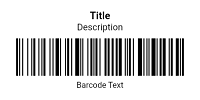The ITF-14 barcode is a high-density, numeric-only symbology used primarily for shipping and logistics. It encodes 14 digits and is used to mark outer cartons and product packaging. This barcode is part of the GS1 system, which ensures global compatibility and standardization in trade and supply chain management.
The ITF-14 barcode, part of the Interleaved 2 of 5 (ITF) family, was developed to address the need for a robust and efficient method of encoding numeric data for logistics. ITF-14 specifically caters to packaging levels above the individual item level, facilitating the tracking and management of bulk shipments.
Technical Specifications
ITF-14 encodes a 14-digit numeric string, including a check digit for error detection. The symbology uses wide and narrow bars to represent each digit. The barcode structure includes quiet zones, start and stop patterns, and the encoded data. ITF-14 is designed to be printed on corrugated cardboard and other packaging materials.
Structure:
- Quiet Zones: Margins on either side of the barcode to ensure proper scanning.
- Start Pattern: A specific bar pattern indicating the beginning of the barcode.
- Data Characters: Each digit is encoded using five bars, with two wide bars interleaved with three narrow bars.
- Stop Pattern: A specific bar pattern indicating the end of the barcode.
Checksum Calculation
The ITF-14 barcode uses a modulo 10 check digit. To calculate the check digit:
- Sum all digits in odd positions.
- Multiply the sum by 3.
- Sum all digits in even positions.
- Add the results of steps 2 and 3.
- Subtract the total from the nearest equal or higher multiple of 10.
- The result is the check digit.
Advantages and Disadvantages
The ITF-14 barcode offers several significant advantages, making it a preferred choice for large-scale logistics and shipping. Its durability is a key feature, as it is specifically designed for printing on corrugated cardboard and can endure the rough handling typically associated with shipping processes. Additionally, the ITF-14 barcode efficiently encodes 14 numeric digits, catering to the needs of extensive logistics operations where high-density data representation is crucial. Being part of the GS1 system, the ITF-14 barcode ensures global compatibility and recognition, facilitating seamless integration across international supply chains.
However, the ITF-14 barcode does have some limitations. It exclusively encodes numeric data, which restricts its use in applications that require alphanumeric information. Furthermore, its relatively larger size compared to some other barcodes can be a disadvantage in environments where space is limited. These factors should be considered when choosing the appropriate barcode type for specific applications and spatial constraints.
ITF-14 Applications
ITF-14 is widely used in shipping and logistics for tracking and managing bulk items. Common applications include:
- Pallet Labeling: Used to identify pallets in supply chain operations, facilitating inventory management and logistics.
- Warehouse Management: Helps in automating inventory control and streamlining warehouse operations by providing a standardized method for identifying bulk shipments.
- Outer Carton Labeling: Marks shipping boxes and cartons, enabling efficient scanning and tracking in warehouses and during transit.
Comparison with Other Barcode Symbologies
ITF-14 barcodes are specifically designed for use on outer cartons and bulk packaging, distinguishing them from UPC and EAN barcodes, which are intended for individual retail items. The ITF-14’s primary advantage lies in its ability to withstand the rigors of shipping and handling, making it a robust choice for packaging environments. This durability is crucial for maintaining the readability of barcodes throughout the supply chain.
In comparison to Code 128 barcodes, ITF-14 offers a trade-off between functionality and durability. While Code 128 can encode a wide range of alphanumeric characters in a more compact form, it is less suited for the harsh conditions encountered in packaging. ITF-14, on the other hand, is specifically engineered to endure the physical stresses of packaging and transportation, making it a more reliable option in these scenarios.
GS1-128 barcodes, while similar in application to ITF-14, differ in their capacity to handle more complex data formats. GS1-128 can encode both alphanumeric characters and variable lengths of data, offering greater flexibility in data representation. However, ITF-14 remains a strong contender in environments where durability and simplicity are prioritized over the ability to encode complex or variable data.


